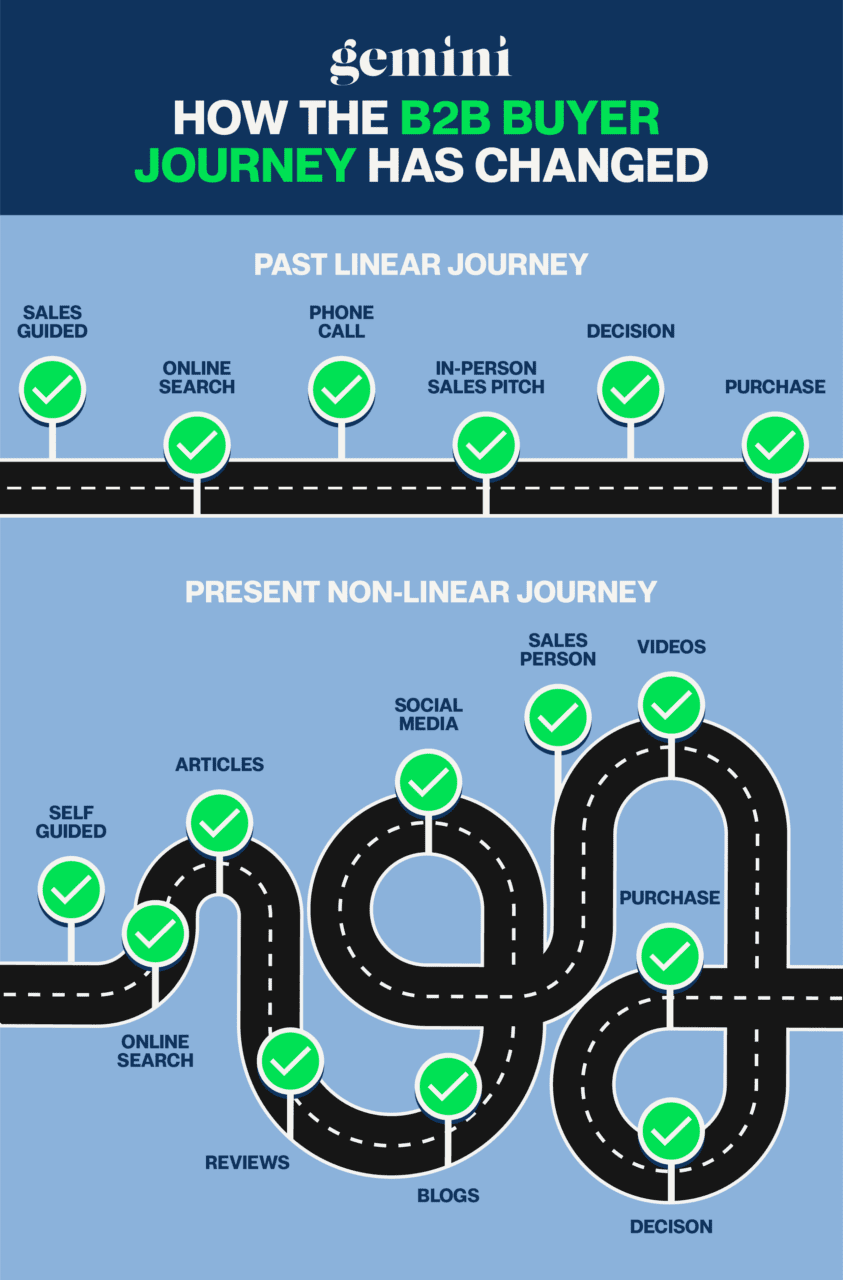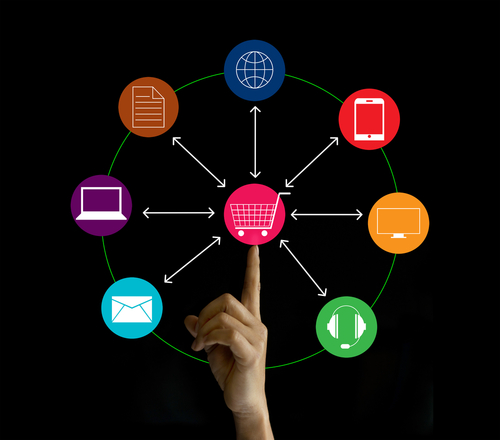B2B buyers are now more independent and resourceful than ever. With the proliferation of valuable online resources, trusted peer groups, review sites, and even self-led product demos, most B2B buyers prefer to do their own research at their own pace. Today’s buyers can gather extensive information about products and services on their own well before talking to a sales team.
According to a study by Gartner, most B2B buyers only spend 17% of the buying process engaging with a sales representative. A study by The Rain Group found that 43% of businesses thought the length of the B2B buying cycle had increased. This means that businesses must optimize their digital presence to attract, engage, and educate potential B2B customers. How do you successfully anticipate what your buyers will need? Settle in, the journey is long.

How the B2B Buying Process Has Changed
In the pre-digital world, B2B buyers would find a provider and connect with their sales team. The sales contact would provide the buyer with equal doses of information and persuasion to help them make their buying decision.
Now, with virtually unlimited information online, buyers do their own research. This means that the journey is no longer a linear one and it doesn’t rely as heavily on impressions made during human encounters. Buyers can effortlessly jump from reviews to case studies to blogs on their own clock without disrupting anyone’s pitch.
Longer Cycles, Content Consumption, and Personalization
This increase in content consumption has led to an extended B2B buying cycle that can take anywhere from a month to a year with the average time hovering around the 3-4 month mark. Having more stakeholders in the mix can also make the process longer as teams compare notes and make collective decisions. Most B2B buyers state that they read at least five articles before talking to a rep. Peer recommendations and social proof have replaced the human component of B2B sales, leaving sales teams a small window of opportunity to close a deal.
Personalization has become the cornerstone of successful B2B marketing. Today’s buyers expect tailored experiences and relevant content throughout their journey. This approach extends to account-based marketing (ABM) strategies, where companies focus on customizing interactions for specific high-value accounts. According to Evergage, 88% of marketers have seen a measurable lift in results due to personalization efforts.
Modern B2B buyers are seeking more than just a transaction; they seek a relationship with brands. Customer experience (CX) has become a key differentiator in the buyer’s journey. According to PwC, 73% of customers say that a good experience is crucial in influencing their brand loyalties. Businesses must focus on delivering exceptional CX at every touchpoint to build lasting relationships with clients.
4 Strategies to Attract B2B Buyers
If you’re a B2B service provider, your challenge is to get potential customers to spend more time engaged with your brand versus your competition. Once you attract prospects, build trust with comprehensive content that clearly speaks to their pain points. Finally, win them over by demonstrating your value. Here’s a more detailed breakdown on how to optimize for B2B buying behavior:
1. Know Your Buyers
The ancient Greek mantra “know thyself” can be updated by B2B marketers to “know thy buyer.” Because of the complexity behind B2B buyer intent, knowing who your customer is and speaking as directly as you can to their needs will serve you best.
Speak to your customers. Identify your best customers, with whom you have a strong relationship. Ask for candid feedback on your product, positioning, and what they value most about you and your offerings.
Additionally, speak to your sales team. They often have great insights into the challenges your customers face every day.
2. Identify Key Touchpoints and Prove Your Value
B2B buyers want thought leadership, not a sales pitch. They’re looking to align themselves with a forward-thinking brand that not only solves their current problems but is looking ahead to anticipate future challenges.
Take a critical look at your marketing funnel and identify which touchpoints customers use most to interact with your brand. Obsess over your attribution data and create personas. Pin down who your buyer is in as much detail as possible. Build trust by creating content along these points that demonstrates how you have solved your customers’ problems in the past. Personalize your content so that it targets the buyer personas you’ve created.
3. Use All Channels for Digital Engagement

B2B buyer behavior can be unpredictable. This puts the burden of proof on you. Build out strong and consistent messaging across a variety of channels to catch buyers at any stopping point. Share your thought leadership wherever a potential customer may be looking and adapt your messaging to their behaviors.
Steps to follow include::
- Optimizing your website with relevant keywords to improve search visibility.
- Creating valuable content, including blog posts, whitepapers, and videos, to address buyer pain points.
- Leveraging social media platforms to engage with your target audience and share valuable insights. 84% of CEOs and VPs use social media to make decisions.
Remember: You’re creating an educational resource, not a sales deck.
4. Produce B2B Case Studies
Potential buyers want to understand how you’d solve their problem. Case studies are the perfect vehicle to demonstrate your expertise, show creative initiative, and share your successes. Let your results speak for themselves.
Leverage customer feedback to show how you understand your customer’s pain points. When a customer praises the results of your work, incorporate it into your case study. Their words are more persuasive than any you could write.
B2B Buyer Intent and the Role of Sales
Even if statistics show that buyers are well-researched by the time they contact sales, your sales team still plays an important role. Buyers need sales to decipher the information they’ve been digesting so that they can make a final decision.
It’s not enough to be a product expert anymore, you have to be an industry expert and consultant. The customer is no longer looking to you to understand the features and benefits, they look to you to understand how the product or solution fits within their business.
It’s crucial to align your digital messaging with your sales messaging so that your buyer has a cohesive journey from discovery to purchase. Work in tandem with your sales team as you create content and build out your channels.
Leverage your sales team for:
- Valuable insights into the behaviors of your customers
- Understanding what factors play into closing a final sale
- Prospecting and lead generation
- Building relationships
- Aligning multiple decision-makers within the buying organization
- Customizing solutions that fit seamlessly into buyer’s existing processes
- Post-sale support
The role of sales in the B2B buyer journey is multifaceted, from initial prospecting to post-sale support. Position sales representatives as trusted advisors, guiding prospects through the decision-making process, addressing concerns, and building strong relationships that lead to successful partnerships and business growth.
Manage the Complexities of Your Buyer’s Journey
The B2B buyer’s journey is in constant flux. An agile, customer-focused digital marketing agency like Gemini can adapt their B2B strategies to cater to evolving customer behaviors and preferences.
By embracing personalization, leveraging technology, and prioritizing customer experience, we can help you meet your B2B clients where they want to be met. Contact Gemini to discuss how we can optimize your customer touchpoints to increase leads and help your sales team close more deals.